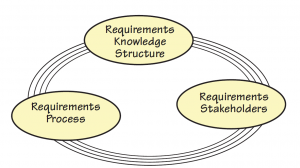*Volere is the Italian verb ‘to wish or want’
From Suzanne and James Robertson:
Volere Requirements Techniques: an Overview
What’s the Point?
The Volere requirements techniques were developed to answer the need for a common language for discovering requirements and connecting them to solutions. The language needs to be understandable by business people, customers, business analysts, engineers, designers, suppliers, testers or anyone else whose input is needed. All of these people have different skills and, not surprisingly, different views on what is important. A language intended for all of these people must recognise the differences in peoples’ viewpoints and yet have a consistent way of communicating and tracing the relevant knowledge. This realisation that requirements is a socio-technical discipline has a strong influence on the development of the techniques.
Since the introduction of the first version in 1995, the Volere requirements techniques have been used on projects in a wide variety of domains such as banking, air traffic control, retail, aviation, government, real-time control, business analysis, manufacturing, just to name a few. The seemingly contradictory characteristics of rigour and flexibility have made the techniques popular as an aid to discovering, understanding, writing and communicating requirements. There are also management advantages like consistent input to estimating, risk management, monitoring, benefit analysis and the basis for reuse.
Volere Provenance
The techniques were evolved by, and continue to be applied and developed by James and Suzanne Robertson. James and Suzanne are principals of the Atlantic Systems Guild, together with Tom DeMarco, Peter Hruschka, Tim Lister and Steve McMenamin. The Guild, founded in 1983, is a practical research organisation devoted to making the best ideas in systems engineering accessible and practical for people developing software, hardware and business processes. All Guild principals are authors of landmark books in the field of systems engineering.
Avoiding reinvention, Volere makes use of established principles, models and practices and builds traceable connections between them. These connections provide a common thread between business or domain requirements, systems analysis models/deliverables, design models/components/deliverables, code and testing. The resulting framework is one that can be used regardless of modelling notation, methodology, degree of agility, development lifecycle or tool usage.
Volere Components
There are three groups of interconnected components.
- The Requirements Knowledge Structure is concerned with how different items of requirements knowledge relate to each other and how to trace requirements from one level to another.
- The Requirements Process is concerned with procedures and activities for how to discover, populate and disseminate the requirements for knowledge.
- The Requirements Stakeholders are the input for determining how much of the knowledge structure needs to be populated for each particular project. The project team uses knowledge of the stakeholders to determine the order in which the work needs to be done and the appropriate level of detail.

Figure 1: The thinking requirements practitioner works to achieve the appropriate balance between requirements knowledge, process and stakeholders. the purpose of Volere is to provide structure and guidance in achieving the appropriate balance for each project.
The detailed contents of each one of these component groups are as follows:
Requirements Knowledge Structure
- a requirements knowledge model that acts as a filing system for requirements knowledge
- a requirements template
- atomic requirements structure
- requirements traceability
- levels of requirements
Requirements Process
- a generic requirements process for discovering requirements knowledge
- how to get started depending on your project characteristics
- requirements trawling/discovery techniques description and guidance
- quality assessment techniques
- goal analysis techniques
- requirements estimation
- requirements specification audit techniques
- prioritisation techniques
Requirements Stakeholders
- stakeholder analysis techniques
- role, knowledge, person analysis
- roles, responsibilities and commitment
- stakeholder feedback techniques
- conflict resolution techniques
- requirements viewpoints
More information is available on the Volere website or on Software Education’s Mastering the Requirements Process MasterClass.